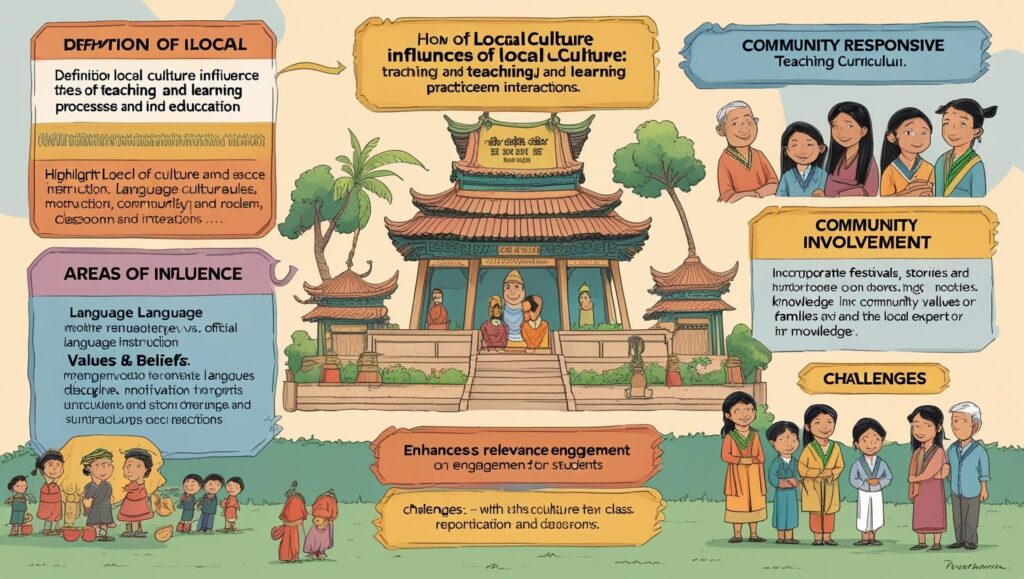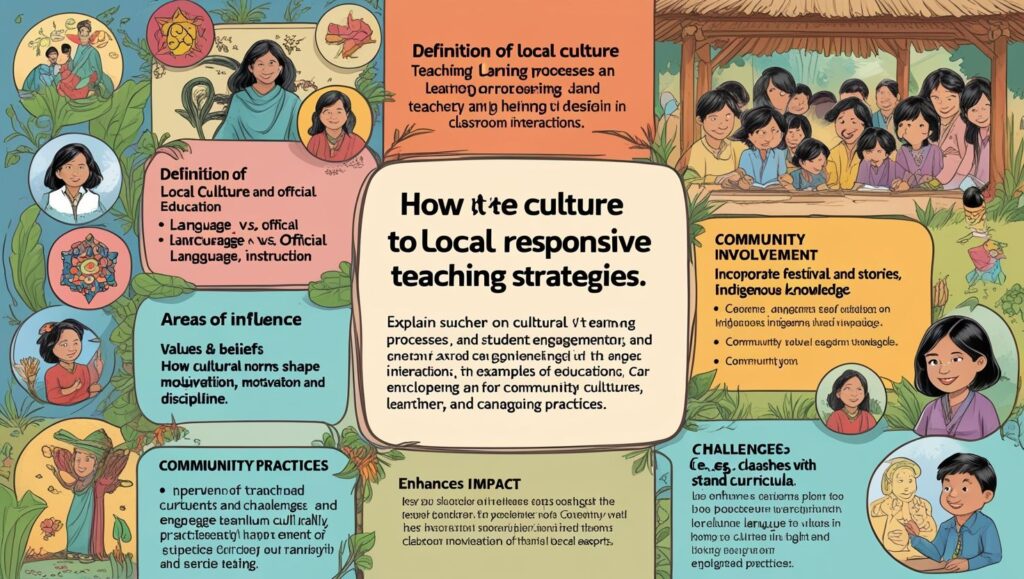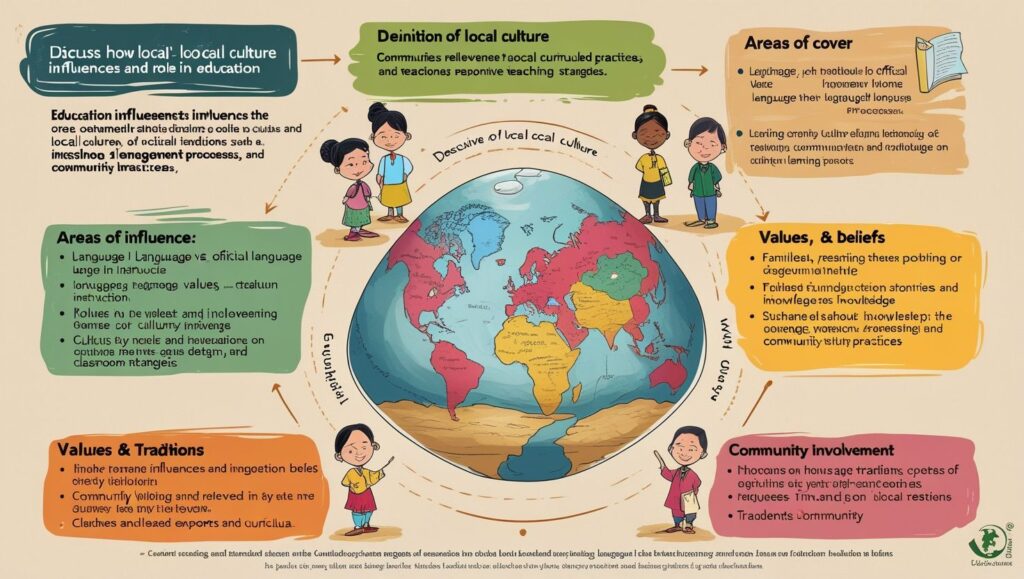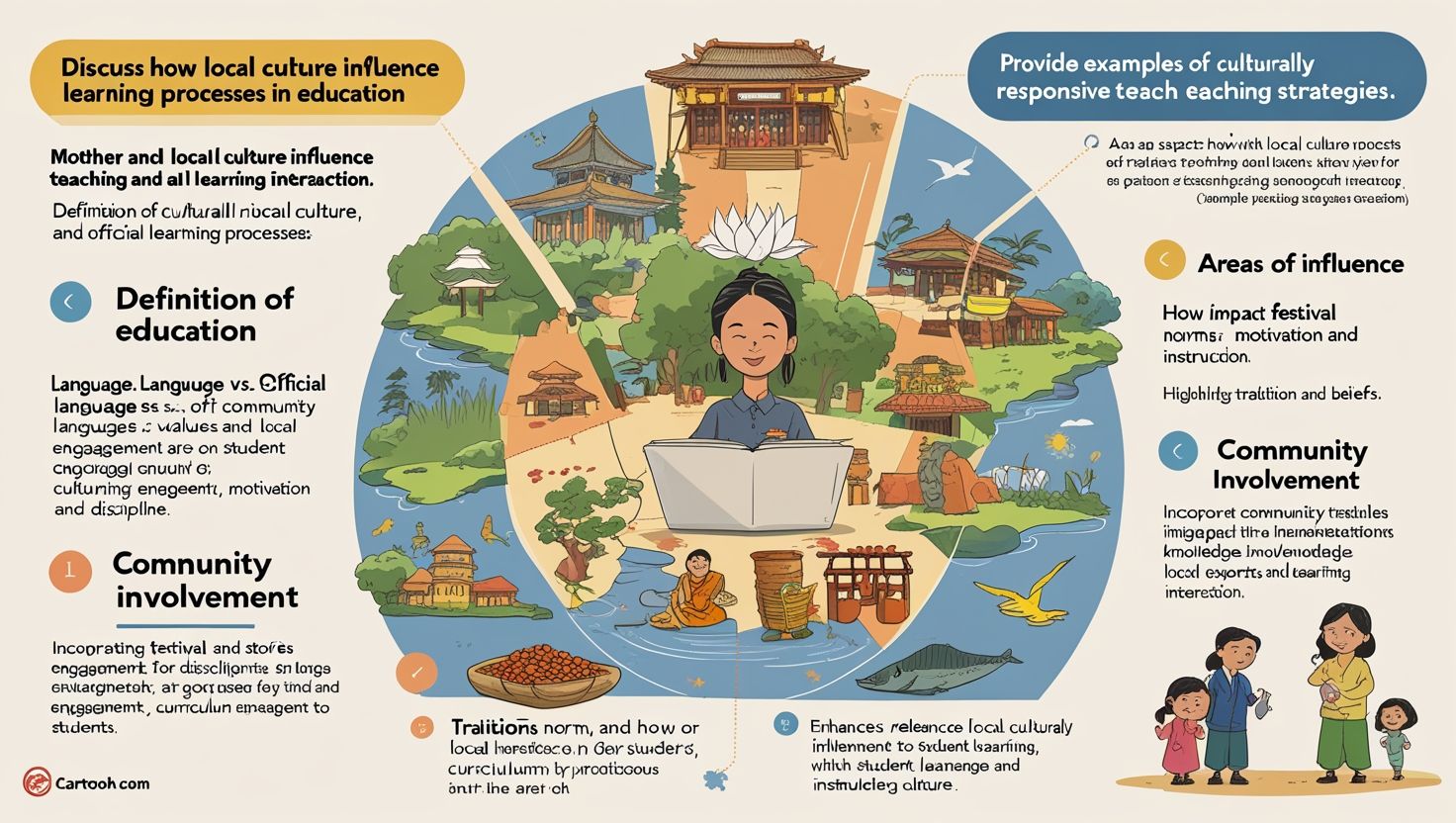1. Introduction
Impact of Local Culture on Learning in Education, Local culture deeply influences education. It shapes values, beliefs, and behaviors. Additionally, it defines how children think and interact. Education does not occur in isolation. Rather, it functions within a cultural context. Therefore, understanding local culture becomes essential. Schools, communities, and families often reflect the culture around them.
Moreover, education systems that ignore local traditions risk failure. Students feel disconnected when their learning environment clashes with home culture. As a result, motivation and participation decline. However, when education embraces cultural identity, students thrive. Learning becomes more engaging and relatable.
Furthermore, cultural heritage influences teaching styles. For example, in collectivist cultures, group learning may be preferred. On the other hand, individualistic cultures may encourage competition. Teachers must consider these elements. Thus, to be effective, education must align with local realities.
In conclusion, local culture is not a barrier. Instead, it is a bridge. It connects students’ lived experiences with academic content. Therefore, respecting and integrating culture improves learning outcomes. Education becomes both meaningful and sustainable when grounded in local values.
2. Cultural Norms and Student Behavior
Cultural norms shape how students behave in schools. These norms influence classroom discipline, participation, and communication. For example, in some cultures, speaking up is discouraged. In others, questioning authority is welcomed. Hence, students may act differently depending on their background.
Additionally, teachers may misinterpret behaviors. A quiet student might be seen as disengaged. Yet, the student may be showing respect. Likewise, a student who argues might seem rude. But they may simply be expressing critical thinking, valued in their culture. Therefore, understanding cultural context is key.
Furthermore, peer interactions are affected by culture. Some students may form groups based on language or tradition. This can lead to inclusion or exclusion. Teachers must foster inclusive environments. By encouraging cultural sharing, they help students understand each other.
Moreover, culture affects gender roles. In certain cultures, girls may be discouraged from active participation. Teachers must navigate these beliefs sensitively. At the same time, they must promote equity.
In short, cultural norms shape how students learn and interact. Recognizing and respecting these norms leads to better classroom management. It also supports emotional and social development. Consequently, learning becomes more productive and harmonious.

3. Language and Communication Styles
Language is a core part of culture. It is more than words; it shapes thought. Different languages and dialects affect how students learn. For instance, students learning in a second language may struggle. They may understand the concepts, but not the words. This creates a barrier to achievement.
Furthermore, communication styles vary culturally. In some cultures, indirect speech is common. In others, directness is valued. This can cause misunderstandings in classrooms. A teacher expecting open dialogue may find students unresponsive. Conversely, a student might feel uncomfortable with public discussions.
Moreover, non-verbal communication is influenced by culture. Eye contact, gestures, and posture carry different meanings. For example, avoiding eye contact might mean respect in one culture but disinterest in another. Teachers must be culturally aware to interpret these signals correctly.
In addition, bilingual or multilingual students bring richness to classrooms. Their language skills can be an asset. When schools support native languages, students feel valued. This also strengthens cognitive abilities and cultural identity.
To conclude, language and communication styles must be considered. They directly impact learning effectiveness. By embracing linguistic diversity, schools can foster inclusion. This approach also enhances academic performance and student confidence.
4. Influence on Teaching Methods
Local culture greatly influences teaching methods. In fact, it determines which teaching styles are accepted. For instance, in some cultures, lecture-based learning is common. Teachers are viewed as authority figures. Students listen and memorize. In contrast, other cultures prefer interactive learning. Students are encouraged to ask questions and explore ideas.
Therefore, teachers must adapt their methods. They need to consider what students are used to. If not, students may struggle to adjust. This can result in low participation or confusion. Hence, culturally responsive teaching is essential.
Moreover, classroom arrangements also reflect culture. In hierarchical cultures, students may sit in rows. In egalitarian settings, group seating is preferred. These arrangements influence communication and collaboration. So, classroom setup must align with cultural comfort.
Additionally, assessment styles vary. Cultures valuing harmony may prefer group projects. Those favoring competition may support individual tests. Teachers should balance both approaches. This ensures fair evaluation and student engagement.
In summary, teaching methods must be flexible. They must reflect cultural expectations. By doing so, educators make learning more accessible. As a result, both students and teachers benefit from smoother interactions and better outcomes.

5. Role of Parents and Community
Parents and community members shape the learning environment. Their beliefs, values, and traditions influence children. Therefore, schools must work with families. When parents are involved, students feel supported. They perform better both academically and emotionally.
In many cultures, education is a shared responsibility. Learning extends beyond school walls. Grandparents, elders, and neighbors may contribute. They pass on knowledge and skills. This collective learning reinforces school lessons. Additionally, it builds cultural pride and identity.
However, cultural misunderstandings can create barriers. For instance, some parents may not attend meetings. Teachers might assume disinterest. Yet, in reality, parents might feel unqualified or unwelcome. Language differences may also be an issue. Therefore, schools must ensure open and respectful communication.
Moreover, involving the community adds richness to learning. Local artists, craftsmen, and storytellers can enhance the curriculum. Field trips to cultural sites build deeper understanding. These activities connect theory with real life.
In short, partnerships with parents and community matter. They support holistic development. By honoring cultural roles and values, schools create a stronger support system. This not only boosts learning but also builds trust and cooperation.
6. Curriculum Relevance and Cultural Content
A curriculum rooted in local culture has many benefits. It becomes more relevant to students’ lives. They see themselves reflected in what they learn. This builds engagement and pride. In contrast, an alien curriculum may seem irrelevant or boring.
Additionally, cultural content makes learning relatable. Traditional stories, history, and customs enrich subjects. For example, math can include local crafts. Science can involve indigenous knowledge. Literature can explore folk tales. These approaches deepen understanding and respect for heritage.
However, many curriculums follow global models. They may ignore local values. As a result, students may feel disconnected. They might struggle to apply learning to real life. Therefore, curriculum designers must include local voices.
Moreover, cultural inclusion promotes diversity. It reduces stereotypes and biases. Students learn to respect differences. They also gain confidence in their identity. At the same time, global knowledge is important. But it should not replace local wisdom. Instead, both should complement each other. This balanced approach prepares students for both local and global roles.
To sum up, curriculum must reflect culture. It should celebrate local traditions while embracing modern knowledge. This combination leads to meaningful and effective education.
7. Motivation and Cultural Identity
Culture shapes motivation in powerful ways. A student’s drive to learn often stems from their cultural identity. When schools respect and reflect this identity, students feel seen. As a result, they become more engaged and motivated.
Furthermore, belonging boosts confidence. When students see their traditions honored, they take pride. They view education as an extension of their lives. Conversely, when culture is ignored, motivation may decline. Students feel alienated and unimportant.
In addition, cultural expectations play a role. In some societies, academic success is a family goal. Parents push children to excel. In others, learning may be seen as secondary to practical work. Teachers must understand these perspectives to guide students effectively.
Moreover, success stories from similar cultural backgrounds inspire. They show students what’s possible. Teachers can highlight local heroes and leaders. This strengthens identity and ambition. Schools can also celebrate cultural events. These events connect students with their roots. They also create positive associations with learning environments.
In short, cultural identity and motivation are linked. By supporting cultural pride, schools enhance academic drive. Therefore, learning becomes not just a task but a meaningful journey.

8. Challenges in Multicultural Classrooms
Multicultural classrooms offer rich diversity. However, they also bring challenges. Students come with different languages, beliefs, and customs. These differences may lead to misunderstandings. For instance, gestures acceptable in one culture may offend another.
Moreover, curriculum may not address all cultures equally. Some students may feel left out. This can create resentment or disengagement. Teachers must strive for balance. Including diverse perspectives fosters inclusivity.
Furthermore, biases can emerge. Teachers may unintentionally favor certain groups. Students may form cliques based on culture. These behaviors can harm classroom unity. Therefore, schools must promote equity and mutual respect. In addition, communication barriers arise. Language differences can limit participation. Students may struggle to express ideas. Teachers need strategies to support these learners. Visual aids, simplified texts, and peer support help.
Assessment fairness is another concern. Standardized tests may not reflect all students’ strengths. Cultural learning styles must be considered. Diverse evaluation methods ensure equal opportunities. Despite challenges, multiculturalism is a strength. It prepares students for global citizenship. With training and awareness, teachers can manage diversity well. They create classrooms where all students thrive.
In conclusion, multicultural classrooms require effort. But the rewards—creativity, empathy, and global awareness—are well worth it.
9. Role of Teachers in Cultural Integration
Teachers play a central role in cultural integration. They bridge the gap between home and school cultures. Their attitudes and actions influence how students perceive learning. Therefore, teachers must be culturally competent.
Firstly, they should learn about their students’ backgrounds. This knowledge helps build trust. It also informs teaching methods. For example, if students value storytelling, lessons can include narratives. If group harmony matters, teachers can use collaborative activities.
Secondly, teachers must avoid stereotypes. Every student is unique, even within the same culture. Labels can harm self-esteem and limit potential. Instead, teachers should celebrate individuality and diversity. Additionally, inclusive language is important. Teachers should use terms that respect all cultures. They should also correct biases respectfully when they appear in class discussions.
Training is essential. Teachers need support in understanding cultural dynamics. Workshops, seminars, and peer learning help improve cultural awareness. Moreover, teachers can involve parents in planning. This ensures that teaching reflects family values. It also strengthens home-school partnerships.
In summary, teachers are key to successful cultural integration. Their efforts create inclusive environments. As a result, students feel respected and motivated. Consequently, learning becomes more effective and joyful.
10. Conclusion and Way Forward
Local culture is vital in shaping education. It influences student behavior, communication, and motivation. It guides teaching methods and curriculum relevance. When education respects culture, it becomes meaningful. Learning connects with real life. However, challenges exist. Diversity can cause misunderstandings. Curriculum may overlook local voices. Teachers may lack cultural training. Yet, these issues are solvable. With awareness, inclusivity, and flexibility, schools can adapt.
Moreover, involving parents and communities strengthens cultural connections. Celebrating traditions and using native languages enriches learning. Students gain confidence and pride in their identity. Going forward, policymakers must prioritize cultural integration. Curriculum development should include community input. Teacher training should focus on cultural competence. Schools should create inclusive spaces for all backgrounds.
In conclusion, culture is not a barrier. It is a foundation. When respected, it becomes a powerful tool. It connects students to their heritage while opening doors to the world. Ultimately, education rooted in culture leads to deeper, lasting learning. It prepares students not only for exams but for life.

ak9b30
lxuqq1